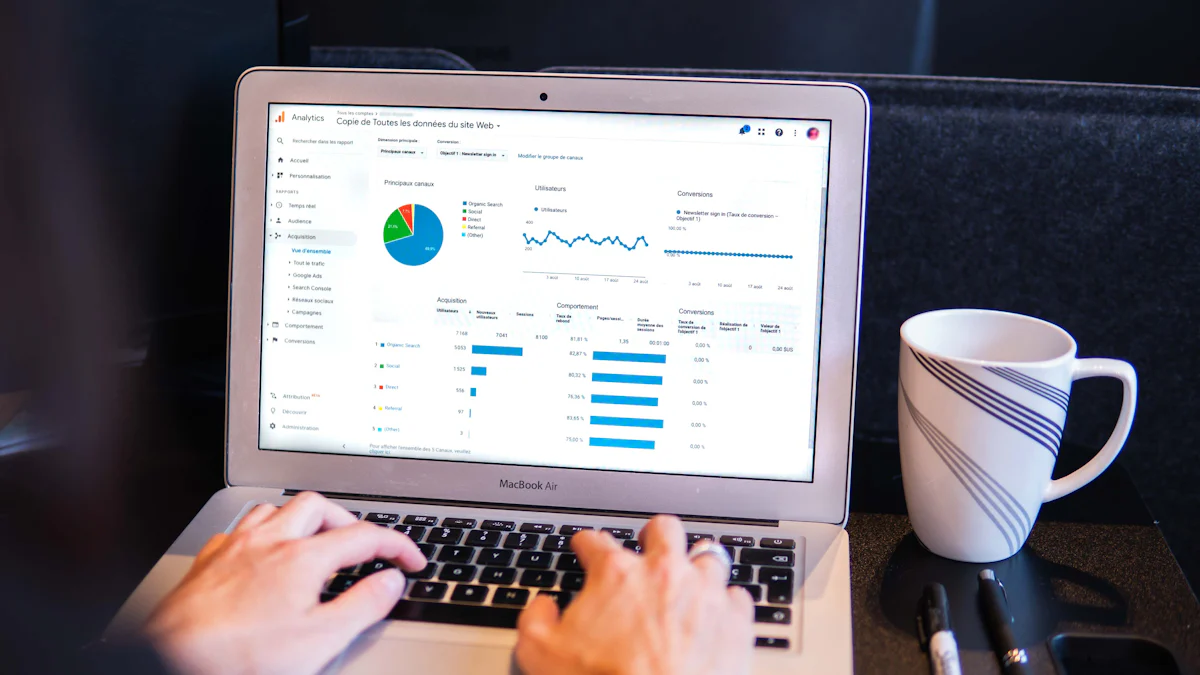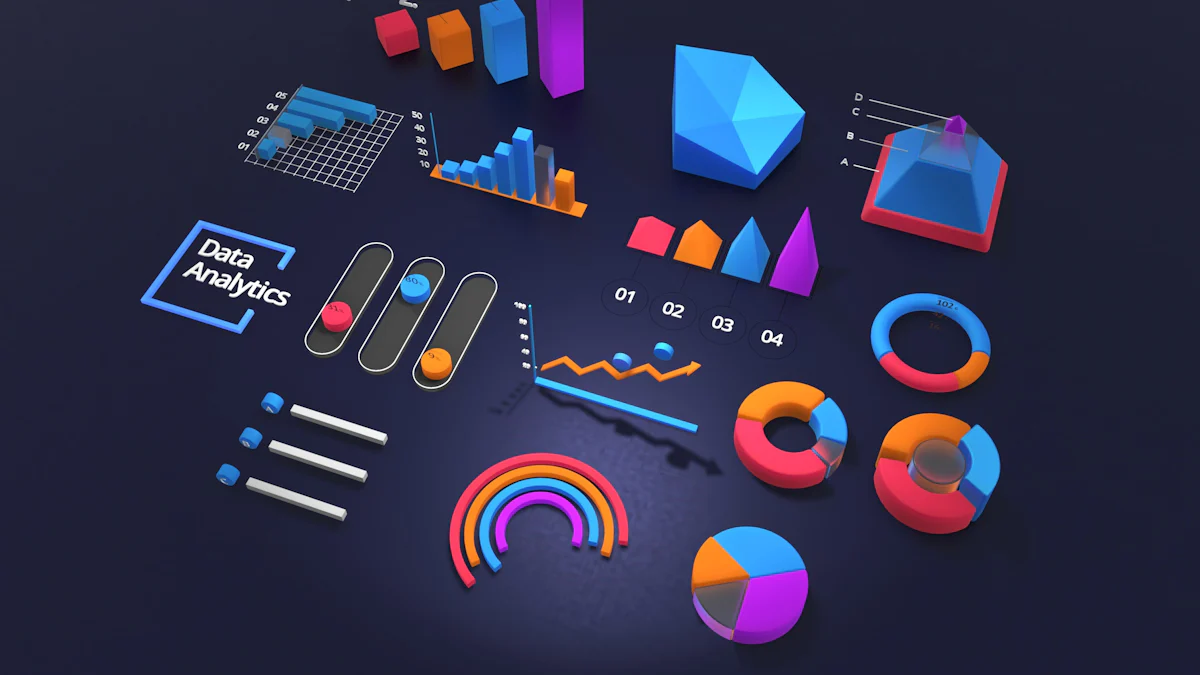

Business Intelligence Trends
Sean, Industry Editor
Oct 08, 2024

Business intelligence (BI) empowers you to transform raw data into meaningful insights. Staying updated with Business Intelligence Trends is crucial. It helps you harness the full potential of your data. According to a survey by Sisense, 49% of companies have increased their use of BI analytics since the pandemic. This highlights its growing importance. BI plays a pivotal role in decision-making and strategy formulation. It enables you to make informed choices that drive success. Gartner reports that while ABI usage has grown in 87% of organizations, only 29% of employees use it. This underscores the need for broader adoption.
Business Intelligence Trends: Data Visualization Advancements

In the realm of Business Intelligence Trends, data visualization advancements stand out as a pivotal development. Modern data visualization tools have revolutionized how you interpret and interact with data. They offer quicker insights and real-time analysis, making it easier for you to transform raw data into actionable insights.
Interactive Dashboards
Interactive dashboards have become a cornerstone of modern business intelligence. They allow you to engage with data dynamically, providing a more intuitive understanding of complex datasets.
Real-time Data Integration
Real-time data integration is a game-changer. It ensures that you have access to the most current data, enabling timely decision-making. With real-time updates, you can monitor changes as they happen, allowing for immediate responses to emerging trends or issues.
User-friendly Interfaces
User-friendly interfaces make data visualization accessible to everyone, not just data scientists or IT professionals. These interfaces simplify the process of data analysis, allowing you to focus on insights rather than the mechanics of data manipulation. This accessibility empowers you to make informed decisions without needing extensive technical expertise.
Augmented Analytics
Augmented analytics represents another leap forward in Business Intelligence Trends. By leveraging advanced technologies, it enhances your ability to derive insights from data.
AI-driven Insights
AI-driven insights automate the analysis process, providing you with deeper and more accurate interpretations of data. Artificial intelligence identifies patterns and trends that might be missed by manual analysis, offering you a competitive edge in strategic planning.
Natural Language Processing
Natural Language Processing (NLP) allows you to interact with data using everyday language. This innovation makes it easier for you to query data and receive insights without needing to learn complex query languages. NLP democratizes data access, ensuring that you can engage with business intelligence tools effectively.
Business Intelligence Trends: AI and Machine Learning Integration
Artificial Intelligence (AI) and Machine Learning (ML) have become integral components of modern business intelligence. They transform how you interact with data, offering predictive insights and automating complex processes.
Predictive Analytics
Predictive analytics leverages AI and ML to forecast future events. You can use these technologies to transform raw data into actionable intelligence. This capability allows you to anticipate trends and make informed decisions.
Forecasting Models
Forecasting models use machine learning algorithms to analyze historical data. These models identify patterns and predict future outcomes with remarkable accuracy. By employing forecasting models, you can plan strategies effectively and stay ahead of the competition.
Risk Management
Risk management benefits significantly from predictive analytics. You can assess potential risks by analyzing data trends and patterns. This proactive approach helps you mitigate risks before they become significant issues, ensuring smoother operations.
Automation of Data Processes
AI and ML automate various data processes, enhancing efficiency and accuracy. You can streamline operations by reducing manual intervention in data handling.
Data Cleaning
Data cleaning is a crucial step in data analysis. AI-powered tools automate this process, ensuring that your data is accurate and consistent. By automating data cleaning, you save time and reduce errors, allowing you to focus on deriving insights.
Pattern Recognition
Pattern recognition is another area where AI excels. Machine learning models analyze large datasets to identify trends and patterns. This capability enables you to uncover hidden insights and make data-driven decisions with confidence.
Business Intelligence Trends: Cloud-based BI Solutions
Cloud-based BI solutions have revolutionized how you manage and analyze data. They offer unparalleled scalability and flexibility, allowing you to adapt quickly to changing business needs.
Scalability and Flexibility
Cloud-based solutions empower you to scale your operations effortlessly. You can adjust resources based on demand, ensuring optimal performance without overcommitting to infrastructure.
Cost Efficiency
You benefit from cost efficiency with cloud-based BI. Traditional systems require significant upfront investment in hardware and software. In contrast, cloud solutions operate on a subscription model. This approach reduces capital expenditure and aligns costs with usage, making it easier for you to manage budgets.
Remote accessibility is a key advantage of cloud-based BI. You can access data and insights from anywhere, at any time. This flexibility supports remote work and collaboration, enabling you to make informed decisions regardless of location.
Security Enhancements
Security remains a top priority in cloud-based BI solutions. Providers implement robust measures to protect your data, ensuring compliance with industry standards.
Data Encryption
Data encryption safeguards your information. It converts data into a secure format, preventing unauthorized access. You can trust that your sensitive data remains protected, even during transmission.
Compliance Standards
Compliance with standards like GDPR and CCPA is crucial. Cloud providers adhere to these regulations, ensuring that your data management practices meet legal requirements. This compliance gives you peace of mind, knowing that your organization operates within the law.
"Business Intelligence Solutions Empower Organizations" highlights the core role of BI in modern organizations. By leveraging cloud-based solutions, you can do more with your collected data, driving innovation and efficiency.
Business Intelligence Trends: Self-service BI Tools
Self-service BI tools have revolutionized how you interact with data. Self-service BI tools empower you to explore and analyze data without needing extensive technical expertise. They make data accessible to everyone, not just IT professionals or data scientists.
Empowering Non-technical Users
Self-service BI tools are designed to empower non-technical users. They provide intuitive interfaces that simplify data interaction. You can easily navigate through data sets and generate insights without needing to write complex queries.
Intuitive Interfaces
Intuitive interfaces are a hallmark of self-service BI tools. They allow you to interact with data using simple drag-and-drop features. This ease of use means you can focus on understanding the data rather than figuring out how to access it. For example, 2 Brothers Moving & Delivery found traditional data tools too complex. By partnering with Grow, they simplified their data processes, making crucial information accessible and engaging for their team.
Customizable Reports
Customizable reports are another feature that empowers you. Customizable reports allow you to tailor reports to meet your specific needs, ensuring that you get the most relevant insights. This customization allows you to present data in a way that is meaningful and actionable for your organization.
Reducing IT Dependency
Self-service BI tools reduce your dependency on IT departments. They streamline processes, allowing you to handle data tasks independently. This independence speeds up decision-making and enhances productivity.
Streamlined Processes
Streamlined processes mean you can perform data analysis more efficiently. Self-service BI tools automate many tasks, reducing the time and effort required to manage data. This automation allows you to focus on strategic activities rather than routine data handling.
Faster Decision-making
Faster decision-making is a significant advantage of self-service BI tools. With quick access to data and insights, you can make informed decisions promptly. This agility helps you respond to market changes and seize opportunities as they arise.
"Business Intelligence is about making data easier to manage," says Grow.com. By leveraging self-service BI tools, you can transform how your organization interacts with data, driving innovation and efficiency.
Business Intelligence Trends: Mobile BI

Mobile Business Intelligence (BI) transforms how you access and interact with data. It provides the flexibility to stay connected with your business insights, no matter where you are. This trend empowers you to make informed decisions on the go, enhancing your ability to respond swiftly to changing business environments.
On-the-go Access
Mobile BI ensures that you have access to critical data at your fingertips. This capability allows you to remain productive and informed, even when you're away from your desk.
Mobile-friendly Dashboards
Mobile-friendly dashboards present data in a format optimized for smaller screens. You can easily navigate through these dashboards, gaining insights without the need for a computer. This accessibility ensures that you can monitor key performance indicators and track progress in real-time, regardless of your location.
Real-time Notifications
Real-time notifications keep you updated with the latest developments. You receive alerts about important changes or trends as they happen. This feature enables you to act promptly, addressing issues or capitalizing on opportunities without delay.
Enhanced Collaboration
Mobile BI fosters collaboration among team members. It allows you to share insights and work together seamlessly, regardless of geographical barriers.
Sharing Insights
Sharing insights becomes effortless with mobile BI. You can distribute reports and visualizations to your team with just a few taps. This ease of sharing ensures that everyone stays informed and aligned with the organization's goals.
Team Integration
Team integration improves as mobile BI tools facilitate communication and coordination. You can collaborate on data analysis and decision-making processes, enhancing the overall efficiency of your team. This integration supports a cohesive approach to achieving business objectives.
"Business Intelligence professionals emphasize the importance of identifying insights from complex business data," highlighting the role of mobile BI in staying competitive and solving business problems.
Business Intelligence Trends: Data Governance and Privacy
In today's data-driven world, maintaining data governance and privacy is crucial. You must ensure that your business complies with regulations and manages data quality effectively. This section explores the importance of regulatory compliance and data quality management in business intelligence.
Regulatory Compliance
Regulatory compliance is essential for protecting consumer rights and maintaining trust. You need to understand and adhere to various regulations that govern data usage.
GDPR and CCPA
The General Data Protection Regulation (GDPR) and the California Consumer Privacy Act (CCPA) are two significant regulations you should be aware of. GDPR gives EU citizens more control over their data. It empowers them with rights such as knowing what data is collected, opting out of processing, and requesting data deletion. Similarly, CCPA strengthens the rights of California residents. It allows them to know about data collection, opt out of the sale of personal information, and request data deletion. Non-compliance with these regulations can result in hefty fines, so it's vital to implement robust data protection strategies.
Industry-specific Regulations
Different industries have specific regulations you must follow. For example, financial institutions must adhere to strict security measures to protect sensitive information. Understanding and complying with these industry-specific regulations is crucial for maintaining operational integrity and avoiding legal issues.
Data Quality Management
Data quality management ensures that the data you use is accurate and reliable. It involves maintaining data accuracy, consistency, and lineage.
Accuracy and Consistency
Accurate and consistent data is the foundation of effective business intelligence. You need to ensure that your data is free from errors and inconsistencies. This involves regular data cleaning and validation processes. By maintaining high data quality, you can make informed decisions and gain valuable insights.
Data Lineage
Data lineage refers to the tracking of data's origin and changes over time. Understanding data lineage helps you ensure data integrity and traceability. It allows you to identify the source of data issues and rectify them promptly. By managing data lineage effectively, you can enhance data transparency and trustworthiness.
"Data governance and privacy are not just about compliance; they are about building trust with your customers," emphasizes the importance of adhering to regulations and maintaining data quality.
Business Intelligence Trends: Big Data and IoT Integration
The integration of Big Data and the Internet of Things (IoT) is transforming how you handle and utilize data. This trend allows you to harness vast amounts of information from various sources, providing deeper insights and enhancing decision-making processes.
Handling Large Data Volumes
Managing large data volumes is a critical aspect of this integration. You need efficient solutions to store and process the immense data generated by IoT devices.
Storage Solutions
Storage solutions play a vital role in managing big data. You can use cloud-based storage to accommodate the growing data needs. These solutions offer scalability, allowing you to expand storage capacity as required. By leveraging cloud storage, you ensure that your data remains accessible and secure.
Processing Speed
Processing speed is crucial for analyzing large datasets. High-speed processing enables you to extract insights quickly. You can use advanced analytics tools to process data in real-time, ensuring timely decision-making. This capability allows you to respond swiftly to emerging trends and opportunities.
IoT Data Utilization
IoT devices collect detailed data through sensors, providing valuable insights into various aspects of your business. Utilizing this data effectively can lead to significant improvements in operations and strategy.
Real-time Monitoring
Real-time monitoring is a key benefit of IoT data utilization. You can track processes and systems continuously, identifying issues as they arise. This proactive approach helps you maintain operational efficiency and prevent potential problems before they escalate.
Predictive Maintenance
Predictive maintenance is another advantage of IoT data. By analyzing data trends, you can anticipate equipment failures and schedule maintenance accordingly. This strategy reduces downtime and extends the lifespan of your assets, leading to cost savings and improved productivity.
"The combination of IoT and big data analytics empowers organizations," enabling you to achieve greater efficiencies, anticipate potential problems, and make smarter decisions. This integration is a powerful tool in your business intelligence arsenal, driving innovation and success.
You’ve explored key Business Intelligence Trends that shape the future of data-driven decision-making. These trends, like AI integration and self-service tools, enhance your ability to harness data effectively. Looking ahead, expect even more sophisticated technologies that prioritize data quality and security. Industries will benefit from these advancements by improving operational efficiency and fostering innovation. Embracing these trends ensures you stay competitive and responsive in a rapidly evolving landscape.
FAQ
The top trends include enhancing data security, improving data quality, cultivating a data-driven culture, strengthening data governance, and increasing data literacy. These trends are reshaping industries by making business intelligence technologies more sophisticated and user-friendly.
Augmented analytics leverages AI to automate data analysis. It helps you uncover deeper insights quickly, allowing for more informed decision-making. This trend empowers you to drive innovation and gain a competitive edge.
NLP allows you to interact with data using everyday language. This makes data access more intuitive and accessible, enabling you to query and understand data without needing technical expertise.
Data storytelling transforms complex data into engaging narratives. It helps you communicate insights effectively, making it easier for stakeholders to understand and act on the information.
Self-service analytics tools provide intuitive interfaces that allow you to explore and analyze data independently. This reduces reliance on IT departments and speeds up decision-making processes.
Cloud-based BI solutions offer scalability and flexibility. They allow you to access data from anywhere, support remote work, and reduce costs through subscription models.
Predictive analytics uses historical data to forecast future trends. This enables you to anticipate changes and make proactive decisions, improving strategic planning and risk management.
Ethical data governance ensures that data is managed responsibly. It helps you comply with regulations, protect consumer rights, and build trust with customers.
Continue Reading About Business Intelligence Trends
10 Game-Changing Project Management Reporting Types!
Unlock project success with 10 must-know reporting types! Track progress, manage risks, and stay on budget like a pro.
Lewis
Mar 03, 2025
10 Must-Have Marketing Agency Reporting Tools for Your Success
Optimize your agency's performance with top reporting tools. Explore analytics, social media, SEO, and more for data-driven decisions and efficiency.
Lewis
Oct 09, 2024
15 Best Software Reporting Tools for 2025
Explore the top 15 software reporting tools for 2025. Compare features, pricing, and usability to find the best fit for your business needs.
Lewis
Oct 08, 2024
2025 Best Data Integration Solutions and Selection Guide
Explore top data integration solutions for 2025, enhancing data management and operational efficiency with leading platforms like Fivetran and Talend.
Howard
Dec 19, 2024
2025 Data Pipeline Examples: Learn & Master with Ease!
Unlock 2025’s Data Pipeline Examples! Discover how they automate data flow, boost quality, and deliver real-time insights for smarter business decisions.
Howard
Feb 24, 2025
2025's Best Data Validation Tools: Top 7 Picks
Explore the top 7 data validation tools of 2025, featuring key features, benefits, user experiences, and pricing to ensure accurate and reliable data.
Howard
Aug 09, 2024


